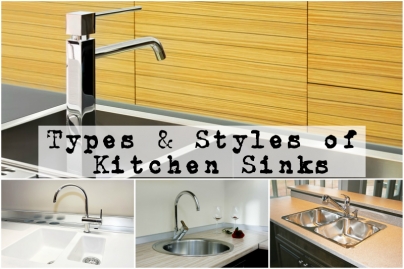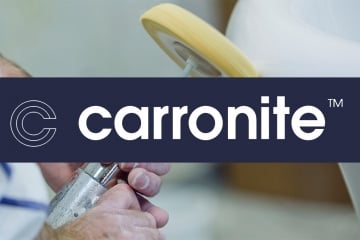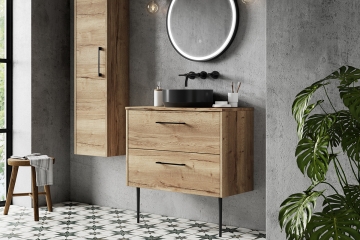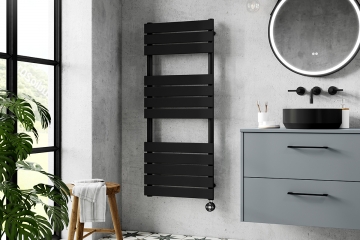Types & Styles of Kitchen Sinks - A Buyers Guide

Types & Styles of Kitchen Sinks
When it comes to choosing what type of kitchen sink will sit in your kitchen, the first thing you need to consider is the durability. A sink isn't something you're going to replacing every year, it needs to last for years to come. Kitchen sinks tend to get heavy use, and with all those bashes and knocks that can happen when you're washing the dishes, you're going to want one that can stand up to such use.
Below we've listed the types and styles of kitchen sinks that you'll find here at Heat & Plumb. We've listed the pros and cons for most of them too, so you can really weigh up what type of kitchen sink fits your personal situation.
Stainless Steel Kitchen Sinks
The stainless steel kitchen sink is the most popular type of kitchen sink in the UK, and there's good reason for that. This popularity is due to the immense durability of stainless steel, making it far more scratch-resistant than other types of material used in sink construction. It's easy to clean and maintain them too, ensuring that the surface will always remain as dazzling as the day it was installed. Finally, stainless steel sinks are versatile. They'll match a range of styles - from contemporary to traditional - and you'll find a wide range of taps and other appliances that will match the look.
So, in terms of practicality, a stainless steel sink is an excellent choice for the kitchen. But what about design?
Thankfully there's a multitude of options, from sinks that will fit the smallest kitchen to 2 bowl giants that increase productivity in even the busiest kitchens. Other options include various finishes and drainer options, while prices start so low that you'll get superb value for money.
Pros of stainless steel kitchen sinks:
- Highly durable and hardwearing.
- Doesn't scratch easily.
- Versatile style.
- Prices start low.
Cons of stainless steel kitchen sinks:
- While there are different sizes and bowl styles available, they lack the variety of the high-end decor market.
- Can be quite loud when something is dropped on them.
- Abrasive cleaners can scratch them. Also, keep them dry so calcium deposits don't build-up - especially in hard water areas.
Ceramic Kitchen Sinks
Ceramic kitchen sinks are what you would have traditionally found in the British country home. That 'farmhouse' feeling is now catching on again in a big way, with ceramic sink sales becoming more popular year-on-year. When you run your fingers across the silky surface of ceramic, you'll realise why this type of sink is one of the best in terms of quality and overall attractiveness. But don't feel like the traditional nature of this sink means you must design a traditional kitchen around it, as this design will work just as well in contemporary designed kitchens.
When it comes to installing, it couldn't be easier. Regular maintenance is a breeze too, as you only have to remember to regularly give it a quick wipe down in order to keep it stain-free and looking its best. In terms of size, they can be just as big as other sinks, although remember that a larger size means a higher cost; especially as these sinks tend to handcrafted.
Pros of ceramic kitchen sinks:
- Won't dent like stainless steel can.
- Seamless sealed fitting.
- Silky smooth surface.
- Heat and stain resistant.
- Not just white or cream - a variety of colours can be found.
Cons of ceramic kitchen sinks:
- Easy to smash objects such as glassware on the ceramic surface.
- If chips and cracks do eventually appear, the surface around the damage can discolour.
Belfast Kitchen Sinks
If your tastes tend to fall on the more traditional side, Belfast kitchen sinks may be the option for you. Also known as butler sinks, they got this name because the butler would be the one using it in a posh traditional home. Stylistically they can also be classed as 'farmhouse' style sinks. From a practical point of view, Belfast kitchen sinks are deeper than your average sink, giving you plenty of space in which to wash those larger kitchen utensils. Traditionally it's depth meant it was easier to wash clothes in - or even a baby!While the Belfast sink is generally one bowl, there are two bowl versions available too if you need that extra washing space. The makeup of the sink tends to be made of fireclay or glazed white porcelain, both of which give the sink a silky-smooth and quality feel. Prices start around £100.
While the Belfast sink is generally one bowl, there are two bowl versions available too if you need that extra washing space. The makeup of the sink tends to be made of fireclay or glazed white porcelain, both of which give the sink a silky-smooth and quality feel. Prices start around £100.
The pros and cons of Belfast kitchen sinks are very similar to ceramic kitchen sinks, but we'll go through them again with a couple of additions.
Pros of Belfast kitchen sinks:
- Perfect if you're wanting a more traditional style of sink.
- Deep, giving you more practical space to complete kitchen chores.
- Won't dent.
- Resistant to hot temperatures.
Cons of Belfast kitchen sinks:
- Surface will easily smash plates and glasses that are dropped on it.
- Can becoming cracked or chipped if not looked after properly.
- If a crack or chip develops, the area around can discolour.
Composite Kitchen Sinks
Made up of a combination of different materials, composite kitchen sinks are designed to have the appearance of a granite sink without the hefty price tag. These sinks are normally manufactured by mixing together granite stone dust with acrylic resins, which are then moulded into sink form. They're an easy and affordable way to get that expensive look without tricky installations and a hefty whack to your wallet.
With hundreds of different styles and finishes available, you can get the exact look you desire with little effort and cost.
Pros of composite kitchen sinks:
- Extremely durable, which includes heat, stain, scratch and chip resistance.
- Varied styles, colours and sizes available.
- Consistent, uniform colour, unlike natural granite.
- Great value for money.
Cons of composite kitchen sinks:
- Harsh chemicals can damage them. Always check the documentation for cleaning products to see if they can be used with composite sinks.
- Hard surface, dropping glassware on it will most likely shatter the glass.
- If you want the authentic granite look, composite sinks don't feature variations in pattern and colour.
- Costs more than stainless steel or ceramic sinks.
Undermount Kitchen Sinks
Undermount kitchen sinks are exactly what it says on the tin in that they mount underneath the kitchen worktop. This gives more space around the sink as it's a rimless, minimalist design. The lip is underneath the solid surface of the countertop, so it's a straight shot into the sink. Also, the lack of a lip means it can be easily cleaned, as you can just brush food scraps straight into the sink bowl with no rim to collect dirt.
Installation can be a bit trickier than other sinks as it needs to be fully sealed and supported to hold the weight of a sink full of water and dirty dishes. Due to this, it's highly recommended that you get a professional to complete the installation. It's also advised that it be fitted with solid surface countertops, such as granite, marble or concrete. Laminate or tile counters aren't a good idea as the seams and grouting are weak points that won't support the weight of the undermount sink.
Pros of undermount kitchen sinks:
- Very attractive.
- Minimalist, space-saving design.
- Easy to clean as there's no rim to collect dirt.
- Can be quite deep.
Cons of undermount kitchen sinks:
- More expensive than other types of sink.
- Requires weight-bearing countertop materials.
- Taps need to be fitted to the wall or the countertop.
Designer Kitchen Sinks
If you want your kitchen sink to be bang on trend or just want to have something a little more unique, designer kitchen sinks are the best of the best. They're ideal for kitchen spaces where an ultra-modern look is the aim, and they come in a wide range of stylish finishes and types of material. But remember that that designer look and build usually carries a higher price-tag, although that striking impact is definitely worth it!
Round Kitchen Sinks
Round kitchen sinks don't seem to be a common site, but if you're after something a little different then read on. They don't take up as much space as other sinks, so if that's an issue for your busy kitchen then maybe this isn't the choice for you. For smaller kitchens where space is at a premium, a round sink is the ideal size.
With a round kitchen sink, you've got the choice of either having it fitted to the countertop or mounted under the surface.
1 Bowl Kitchen Sink
Single bowl kitchen sinks are the most common type of sink, and they offer plenty of space in which to wash big dishes and pots. They usually come with a drainer section where you can leave dishes to dry. 1 bowl kitchen sinks are also known as inset or surface mounted sinks and are compatible with all types of worktops.
There are a vast number of styles available when it comes to single bowl sinks, so you're not spoilt for choice when it comes to finding one to fit your personal kitchen design.
1.5 Bowl Kitchen Sinks
1.5 bowl kitchen sinks give you an extra small bowl next to the main sink bowl and it's ideal for when you're trying to get a lot done at the same time. For example, if your main bowl is full with water because something is soaking in it, you can still drain pots and pans used in cooking in the extra bowl. You could even use it to wash vegetables. It's the ideal way to let you multitask when you're busy cooking dinner for the whole family.
2 Bowl Kitchen Sinks
If you crave more practical space in your busy kitchen, a two bowl kitchen sink is the perfect solution. With two bowls to play with you can get far more done, and you don't have to worry about draining the sink of water because you need to use it for something else. As with single bowls, they come in surface mounted or inset versions and can be used with any work surface.
View our vast range of kitchen sinks and pick the right one for your home or if you still need help, try our kitchen sink guide for other considerations, such as installation and budget.
Related Posts
The patented, triple-layer Carronite reinforcement system has been a staple in the bath industry for 40 years. We dig into the truth behind the strapline...
Choosing between floor-standing and wall-mounted vanity units should be straightforward, but it's actually one of those decisions where both options have genuine advantages and some proper drawbacks that aren't immediately obvious until you've lived with them.
When you're replacing radiators or planning a heating system, the sheer number of options can be a bit baffling. Panel, convector, column, designer - what's the actual difference, and does it matter?




